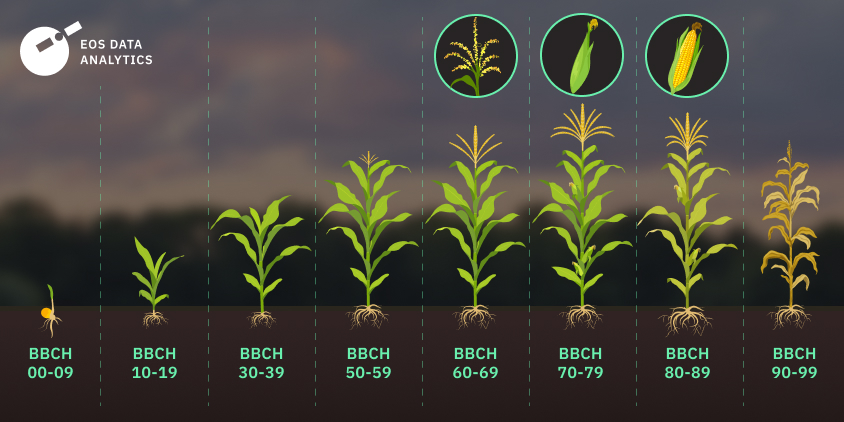
The recommendations provided in this article serve as general guidelines. Particular cultivation requirements may vary based on the unique conditions of each field and the selected hybrids.
Corn Growth Stages: An Advanced Guide On Crop Management
Corn growth can be monitored using a variety of scales, the most common of which is the BBCH-scale. Different stages of corn growth require specific farming activities such as fertilizing, irrigation, and pest control. For example, during the early stages of growth, corn requires a high quantity of moisture and, as a result, active watering, although during the fruit development period, moderate rainfall is usually sufficient. Knowing the corn growth stage helps farmers schedule their field activities at the right time, optimize resource allocation, and improve the overall productivity and sustainability of their crops.
BBCH-Scale For Corn Growth Stages
The basic idea behind the BBCH-scale is to break down a plant’s development into 10 primary growth stages and their respective secondary growth stages. Principal growth stages 2 and 4 are not relevant for corn. For BBCH-scale, a leaf is only considered to be present when it’s unfurled.
Corn plant growth stages according to BBCH-scale
BBCH 00–09: Germination
Germination is the growth stage when enzyme activity within a seed is revived, allowing an embryo to break through the seed coat and develop. Since germination is activated by seed water absorption, the plant is extremely sensitive to climate factors and water stress during this corn development stage.
Weather Conditions
Cool weather during the corn seed germination stage limits nutrient uptake from the soil and inhibits plant growth. A couple of days following a frost, check the corn plant for any signs of damage. If the growing point is pale green or yellow and does not slip, then the leaves should appear in two weeks. If the point is damaged, it’s necessary to replant the corn.
Healthy corn growth relies on timely and uniform planting. EOSDA Crop Monitoring does more than just help farmers with accurate planting times based on the plant requirements during the corn germination stage; it also reveals patterns in the field’s grain distribution.
It is important to assess the soil moisture content and the stage of soil physical maturity before planting. Our precision agriculture platform provides the necessary meteorological data for this purpose, including forecasts for the next 14 days and historical records dating back to 1979. A look at the sum of active temperatures and accumulated precipitation over time can tell you if a field has adequate heat and moisture for corn growth, which hybrid will thrive, whether or not the field requires additional irrigation, and so on.


Our productivity maps also include data from previous years, so farmers can use this knowledge to focus their variable seeding efforts where they will yield the greatest results.
Soil Temperature
Soil temperature is one of the key factors to consider when deciding corn planting dates. If the soil is at least 59°F (15°C) and sufficiently moist, corn germination will be uniform and quick. Soil temperatures below 50°F (10°C) for a lengthy period after planting may inhibit germination and growth.
Over time, low temperatures harm corn plants by slowing their metabolism, decreasing vigor, and making them more susceptible to seedling blight. Besides, when seeds are planted too early, they are often harmed by being soaked in cold water (imbibitional chilling). Keep in mind that at this corn’s stage of growth, imbibitional chilling can deactivate relevant genes even in cold-tolerant hybrids .
Planting corn can begin earlier on sandy soils since they dry out more quickly than heavy soils. On the other hand, sandy soils tend to produce lower stands when early planting is done, because plants on them typically suffer from temperature swings, especially on cold nights.
During the germination stage of the corn life cycle, the plant is highly prone to frost damage. EOSDA Crop Monitoring alerts you when young crops are under cold stress, so you can rapidly find out about the course of the situation and take measures to mitigate potential harm. Even with major crop damage, at this stage, you can still replant the field or sow fresh seeds.

The accurate hyperlocal weather forecast on the platform will also help you prepare for the cold during this critical corn growth stage. Soil that has been adequately watered before a frost better stores warmth, increasing corn’s ability to withstand cold stress.
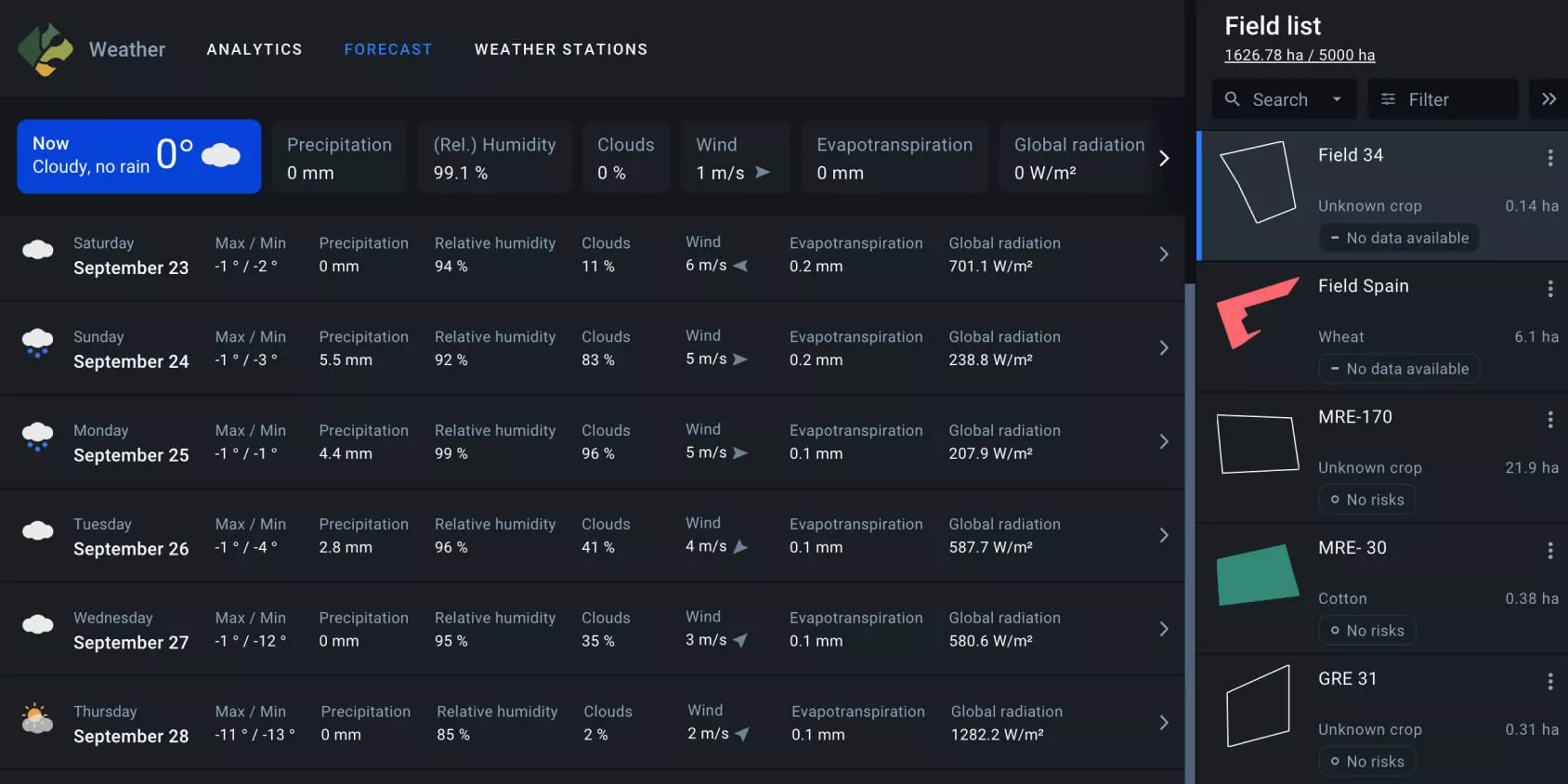
Also, consider the amount of residue in the field. Soil with a lot of residues is less conducive to fast seed germination and growth in the spring. This might also induce corn seedling diseases in fields with poor drainage or a history of seedling blight.
Flooding And Cold Water Stress
Flooding can harm the emergence, survival, and growth of seedlings. At the germination stage of corn development, the majority of hybrids die after being submerged in water for more than 1-2 days, and the smallest seedlings are the most vulnerable. Acidosis, or low pH, can cause cell death in flooded plants.
Even in the best-case scenario, floods and cold stress at this growth stage slow the metabolic rate of corn seedlings, making them more vulnerable to crop diseases, pests, and chemicals. Meanwhile, many pathogenic fungi, like Pythium, flourish in waterlogged environments. Seeds that take longer to germinate are also in greater danger of infection by smut. It accompanies plant growth but only reveals itself at the corn flowering stage. The easiest way to combat smut in corn is to cultivate resistant varieties like Hybrid B840 . To protect your plants from fungus, a pre-sowing fungicide seed treatment is essential.
Damage from floods at this growth stage is not limited to ponded field regions. Flooding damage is also possible in areas where rainfall or poor drainage keeps the soil constantly wet, which stunts any seeds or embryonic corn plants’ growth. You can ensure the healthy growth of your crops by tracking soil moisture at the surface level (up to 20 cm) with EOSDA Crop Monitoring and recognizing soil oversaturation early. Taking preventative actions will allow you to reduce seedling mortality during the germination growth stage and address the issue as soon as possible.

Drought Stress
To germinate, corn seeds must absorb water equivalent to around 30% of their weight . Lack of moisture in the soil around the seed will delay the germination process. Dryness and inconsistent soil moisture at this growth stage of corn are common reasons for uneven crop germination.
Planting too shallowly could make the problem worse because topsoil dries out more quickly. Obstacles that restrict water from reaching the seed also aggravate dry soil’s negative effects at this growth stage. It’s worth considering that in dry soil, the salt effect of fertilizers put into the seed furrow might be much more detrimental to plant growth during corn’s vegetative stages. Because salts draw water, they might dry up the soil or the tissues of developing roots.
To make your corn plants more drought-resistant at this growth stage and throughout their life cycle:
- maintain optimal potassium levels;
- minimize spring tillage to retain soil moisture;
- plant the seed about 2 inches deep for healthy root growth;
- during corn planting, ensure the seed makes good contact with the soil;
- cultivate the soil to enhance its structure and moisture retention while minimizing compaction.
Fertilizing
Phosphorus fertilizer is best applied to accompany seeding since it improves the soil in which the plants will establish their root systems. This planting strategy results in a higher phosphorus concentration during the early stages of corn growth, which improves the plant’s ability to absorb and use phosphorus from mineral fertilizer. This has the triple win of being environmentally friendly, cost-effective, and accelerating the growth and ripening of corn in adverse conditions.
Soil nutrient assessments using satellite technology are not yet accessible. However, laboratory analysis of soil samples before every corn seeding is costly and sometimes inappropriate. One viable method is to evaluate the soil by comparing the prior season’s harvest to the average yield for this region. With this approach, we can do away with vague concepts of “more” or “less” NPK fertilization and instead arrive at definite quantities.

BBCH 10–19: Leaf Development
At the BBCH 13 stage, the corn growing point is still beneath the soil. Thus, waterlogging, especially at high temperatures, can kill plants and lead to significant crop losses.
Frost can drastically reduce corn yields if it hits before the growth of the fifth corn leaf. Plants that have reached the fifth leaf stage are resistant enough to withstand brief frosts as low as 27°F (-3°C). However, even a minor cold is stressful for corn at this growth stage, prompting utmost caution while caring for the plants for a while. Herbicides, in particular, should be avoided at the leaf development stage to prevent extra stress.
To prevent a nutrient deficiency at the corn leaf development stage, nitrogen fertilization is carried out, ideally finishing before the growth of the eighth leaf. When the corn leaves are forming well in some parts of the field while this stage is lagging in other regions of the field, this means problems in the overall crop’s growth. Satellite-based indices can evaluate vegetation density throughout the growth season, allowing for early problem detection and tailoring the fertilizer’s application to specific problem regions.
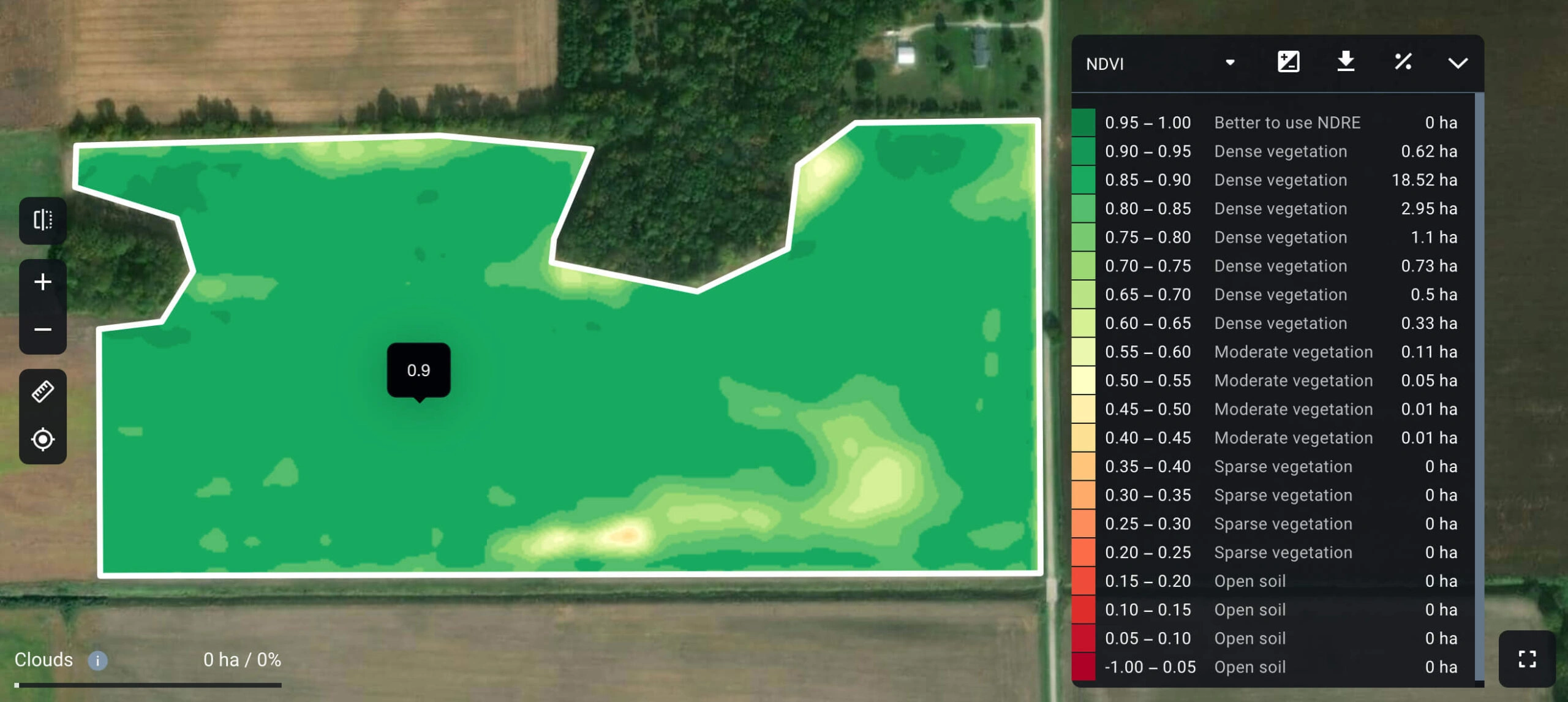
Fungal infections at this stage of plant growth can impair the ability of the corn leaves to photosynthesize, resulting in a loss of grain quantity and quality. Therefore, it is crucial to apply suitable fungicides when pathogens are detected at this growth stage. The fungicide effect lasts between 14 and 21 days.
Weed control during the corn leaf development stage can significantly improve crop productivity. The MSAVI index can be used to track when weeds appear in a field of young corn. With its assistance, you can observe abnormal vegetation growth in the field following corn germination, which is generally a sign of weeds. Once you’ve located weed growth, a scout can be dispatched to this specific field/area to evaluate the severity of the problem so that you can plan weed management actions accordingly.
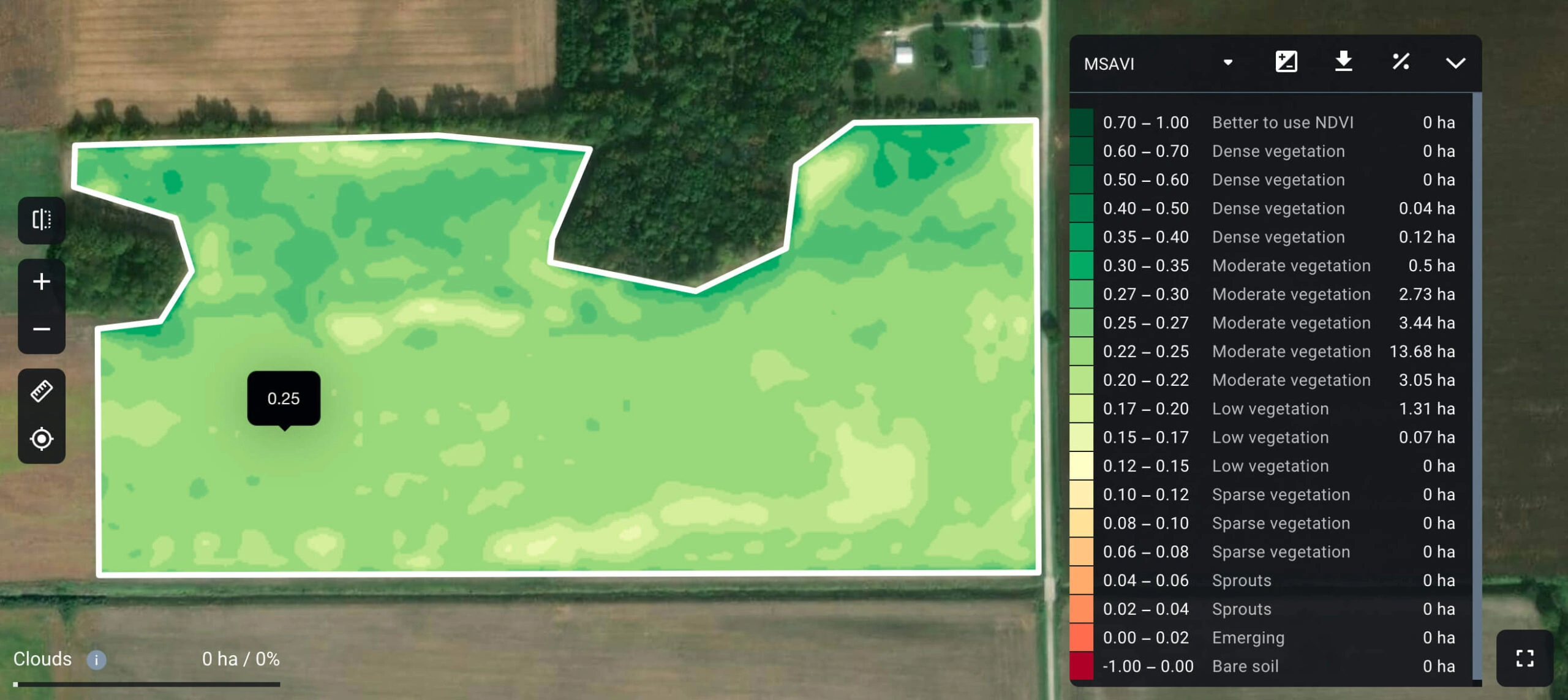
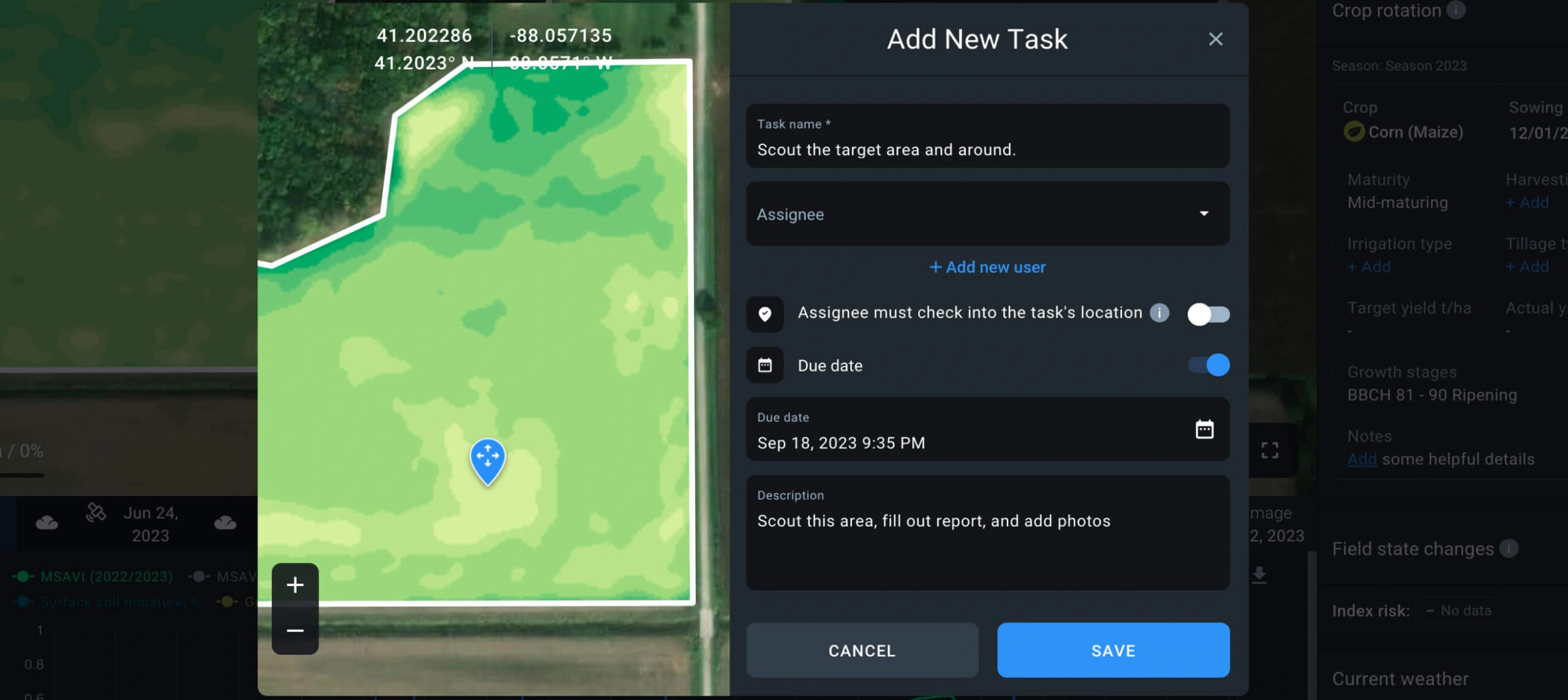
BBCH 30–39: Stem Elongation
At the beginning of this growth stage, corn enters a period of rapid growth and supportive nodal root formation. Up to BBCH 39, this corn growth stage can predict the number of grains that will develop in a given cob row. Keep in mind that the inherited traits of the hybrid you choose will determine the number of grains and the size of the cobs. Early hybrids typically pass through this growth stage more quickly and have smaller cobs.
At this stage of plant growth, corn needs the most nitrogen, along with plenty of water and other nutrients. To prevent cob weight loss, avoid spraying fungicides during the stem elongation stage.
Drought Stress
Corn plants close their stomates and curl their leaves as a drought adaptation strategy. This defense mechanism helps them make it through a temporary drought at different stages of corn development and growth. However, photosynthesis and plant growth are hindered when stomata close. The degree and duration of the stress will ultimately determine its effect on yield: a drop in corn productivity is commonplace when drought stress lasts for 4 days or more.
With EOSDA Crop Monitoring’s Weather risk warnings extension, you can specify a temperature threshold for each field across many regions and receive alerts if the air temperature hits that value. Now, with the proper agricultural practices put in place, corn at any growth stage can better weather a significant temperature rise.

Tillering
During this stage of corn growth and development, plants of nearly all hybrids adapt to available soil nutrients and moisture by forming one or more visible tillers, but some hybrids tiller more than others. This often happens in areas with insufficient plant densities, in rows with skips, and at row ends. Damage to the plant’s primary growing point from things like hail, cold stress, and herbicides can also lead to excessive tillering at this growth stage.
The primary corn stalk can still supply enough water and nutrients to fully develop the grain, regardless of how many tillers sprout from it. In cases of severely low plant stands, tillers can even increase crop yields by providing nutrients to the parent plant or by developing grain on their ears.
Ear Development Under Stress
At the stem elongation stage, setting the kernel rows around the ear occurs. Stresses experienced during this corn growth stage have a significant impact on grain output and the number of harvestable kernels. The application of herbicides (e.g., sulfonylurea) that limit cell proliferation during the ovule development stage can have serious consequences for ear formation. This results in a sudden change in the number of rows of kernels around the corn ear, from a high number at the base to a low number around the tip.
EOSDA Crop Monitoring
Performing fields analytics based on relevant satellite data to ensure effective decision-making!
BBCH 50–59: Inflorescence Emergence, Heading
At this stage of corn growth, the plant’s roots have already grown to a depth of about 5.9 feet (1.8 meters), and the tassel is emerging from the leaf sheath. Any stress on the corn at this growth stage could result in plant development delays or major crop losses. Leaves that wilt early in the morning during the growth stage owing to a lack of moisture can cause daily losses of up to 4%, while hail can even result in crop failure.
There is a great need for both fertilizers and water at this corn growth stage. Giving the plant trace elements that improve its fertility, such as boron (B), water intake, such as zinc (Zn), and photosynthetic productivity, such as manganese (Mn) and magnesium (Mg), raises the odds of successful growth, flowering, and fertilization.
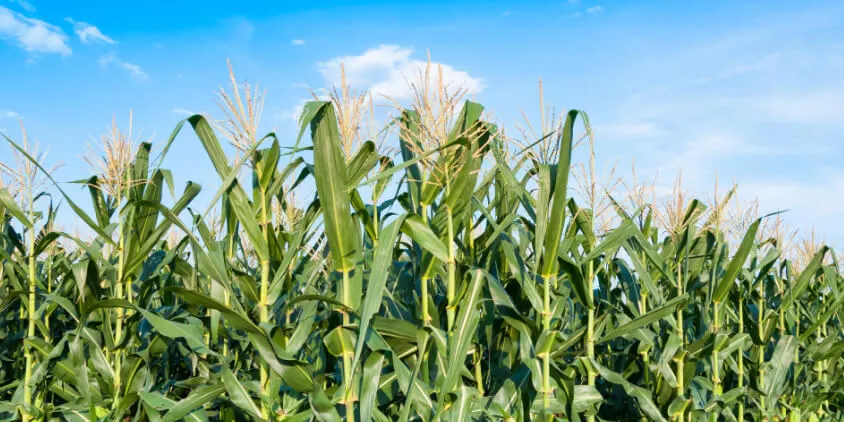
BBCH 60–69: Flowering, Anthesis
Corn is in the flowering stage when the male tassel and female ear appear. The tassel produces the pollen that fertilizes the ovules in the ear. The kernel setting is defined at this growth stage, as its full potential can only be realized if pollination is successful .
Water Deficiency
The corn flowering stage is short, yet water stress at this growth phase can have a major impact on crop output. The plant is unable to adjust to water scarcity during pollination, one of the most water-intensive stages of corn growth. The period of increased susceptibility to the effects of stress begins a week before the silking growth stage and lasts for two weeks afterward. In plants under drought stress, kernel abortion due to decreased photosynthesis and a lack of carbs after pollination can reduce yields by as much as 50%.
When severe drought delays corn silking, the lack of pollen for capture by the late silk can lead to poor grain setting or cob barrenness. The harsh silk behaviors of drought-resistant hybrids make them more tolerant of water deficiency at this growth stage. On the other hand, under favorable conditions, these corn hybrids may produce silk 4-5 days before there’s any pollen. This is why the first silk to appear can’t be pollinated, leading to a low kernel set at the cob’s base .
Because the leaf area of a corn plant at its flowering stage is so much greater than the exposed ground area, crop transpiration during this time accounts for 90–98% of evapotranspiration (ET). Higher levels of sunlight, temperature, and wind speed increase the rate of transpiration, while higher humidity decreases it. Consider that as you map out your precision irrigation program for healthy crop growth.
Heat Stress
Corn yield tends to decrease when seasonal average temperatures rise. The inability of corn at the flowering growth stage to thrive in temperatures above 86°F (30°C) is mostly responsible for this unfavorable correlation. A rise in temperature up to a certain threshold (which varies depending on corn hybrid, growth conditions, and farming practices) generally increases yields, and after the threshold, a dramatic decline in yields occurs.
The tassel’s location makes it vulnerable to intense solar radiation and high temperatures during the reproductive stages of corn growth. This may have the following negative consequences.
The effects of high temperatures on the pollination process
| Temperature | Effect |
|---|---|
| 90°F (32°C) | Effect inhibits pollen germination |
| 95°F (35°C) | Effect dries out any exposed silks and cuts down on pollen production, especially in dry conditions |
| 100°F (38°C) | Effect can destroy pollen |
Long-term exposure to extreme heat during corn reproductive growth stages may drastically diminish the number of fertile pollen grains, which could impact the kernel-setting process. When heat stress is combined with drought and strong winds at the flowering growth stage, the results become even worse. Strong winds blow away moist air and replace it with dry air. The detrimental effects of high winds are most apparent at the edges of the field, where the corn plants are not shielded by other tall crops. Field edges often have the driest air and, therefore, the highest heat stress levels.
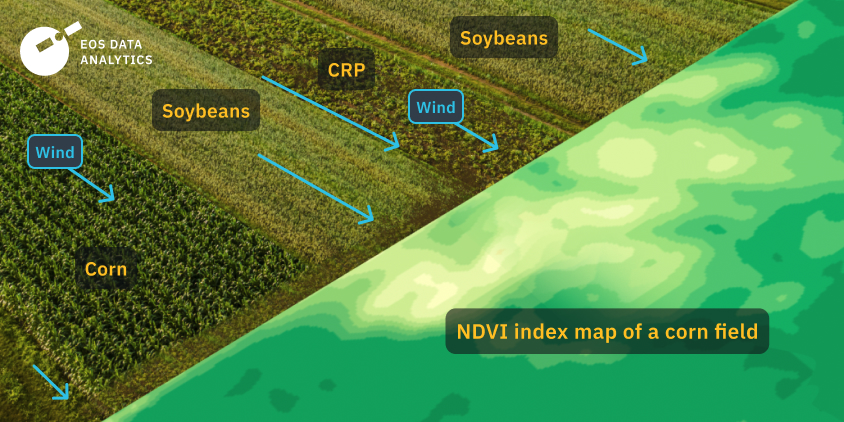
Diseases And Pests
Foliar infections are a serious issue at the corn flowering growth stage. Silking increases a plant’s susceptibility to foliar diseases. Reduced leaf area leads to slower photosynthesis at this growth stage. Meanwhile, related issues, such as stalk rot growth and corn lodging, may further decrease crop productivity.
At the flowering stage, corn is particularly vulnerable to the following pests:
- the Diabrotica beetles damage corn silks and pollen, resulting in insufficient seed formation and growth;
- the second-generation sugarcane borer feeds on the tassels of the corn plant and then burrows into the stem, weakening and eventually breaking it;
- corn stem weevils, as they feed on the internodes of flowering maize plants, chew tiny holes in them.
These grubs are also important vectors for corn diseases like Fusarium stalk rot during the flowering growth stage.
Nutrient Deficiency
The nutrient content of the plant at the flowering growth stage is typically correlated to the yield. Though the plant’s intake of potassium is almost complete at this corn growth stage, due to its essential role in pollination and grain filling, its deficiency can slow the formation of silk and, in the worst scenario, lead to poor kernel setting. A lack of potassium or an overabundance of nitrogen can also cause corn lodging.
To ensure the survival of the kernels at the ear’s butt during times of stress and nutritional scarcity, the corn plants at their flowering growth stage will often relinquish kernels at the ear’s tip. Stressed crops will continue to neglect the tips’ kernels until there’s access to sufficient water and nutrients.
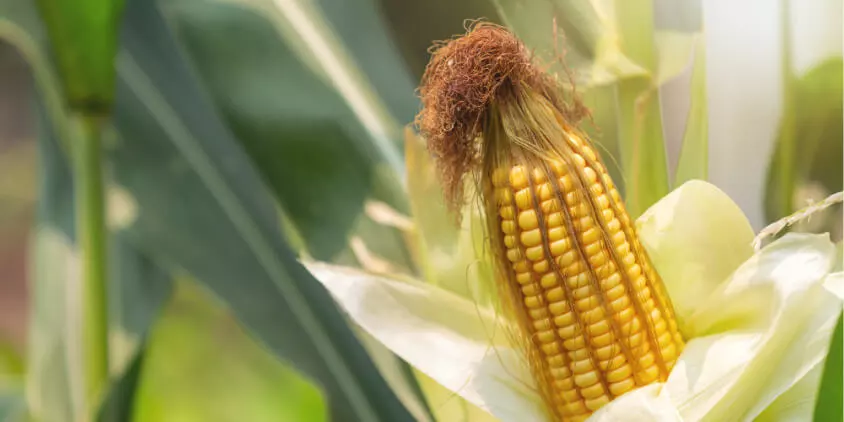
BBCH 70–79: Development Of Fruit
This stage of corn growth is less sensitive to weather fluctuations than earlier phases. The plant requires less water at the stages of grain formation, filling, and ripening. Plus, corn makes efficient use of summer rains for its growth. However, if there isn’t enough moisture during the kernel milk stage, the filling process will end too soon, and the tops of the cobs may either develop a tiny grain or be scanty.
The kernel milk stage, which occurs 20–25 days after pollination (in early-maturing hybrids), is characterized by the presence of a “milky” fluid in the grain. The buildup of nutrients in the grains, which will determine their final weight, continues during this stage of corn growth. Throughout the kernel milk stage, the water content of the grain is between 25 and 55%. Even though this is when corn’s green mass expands the most, only around 75% of the dry matter of the future harvest is present in the grain at this growth stage.
The ideal moisture content of the soil in the root zone for this corn growth stage is between 70 and 80%. Corn grows best at 68–71°F (20–22°C) throughout the milky and full maturity stages, while temperatures as low as 34–37°F (1–3°C) can cause damage and even partial mortality.
If there are a few rows on the cob, the corn growth stages when the fifth–seventh leaf collars show up, probably failed. Fewer kernels per row indicate that somewhere between the tenth leaf collar appearance and the tassel emergence stages, corn suffered from a lack of nutrition or heavy pesticide application. If there are no grains at the end of the cob, the tassel has likely withered from drought during the latter stages of pollination.
BBCH 80–89: Ripening
The ripening growth stage begins when the kernel’s crown develops a hardness and the characteristic lustrous dark yellow hue of ripe kernels . Corn is quite resistant to environmental stress during this growth stage, and its tolerance increases when it reaches physiological maturity.
Ripening
When corn reaches the kernel dent stage, 31–33 days after silking, virtually all of the kernels have developed a dent towards the crown. At the outset of this growth stage, the kernels have a moisture level of roughly 60%.
Notably, at this corn growth stage, the kernel has only amassed around 45% of its final dry matter content, and the plant will need about 30 days to reach physiological maturity. It’s crucial to remember this since farmers often let their guard down once the corn crop reaches the kernel dent growth stage, mistakenly believing that the yield is already guaranteed. Still, intense stress between the dent and physiological maturity stages may prevent the kernel from reaching its full dry weight potential .
In the late kernel dent stage (about 40 days after pollination), the kernel substance is firm but can still be sliced like wax. The grain moisture level has dropped to 17–25% at this growth stage. The kernel dent phase ends, and the corn physiological maturity stage begins when the seed reaches its maximal dry mass. The fastest-maturing hybrids reach full maturity in 50–55 days, depending on the average summer temperatures.
Harvesting
Currently, the main method of corn harvesting is combine-harvester threshing of cobs, shredding, and scattering of residue in the field. This is the best option in terms of cost-effectiveness, as it reduces labor costs by 40–50% and fuel costs by 20–25% compared to traditional harvesting methods.
Corn harvesting might be held up due to a lack of harvesting equipment or unforeseen logistical issues. Fortunately, this is one of the crops for which a slight delay in harvesting is usually not disastrous. Under perfect weather conditions during the delay, the grain moisture in the corn cob may even drop by half a percent or more, which is a boon to the farmer.
However, there are several drawbacks to late harvesting as well. Heavy precipitation during the corn maturity stage can increase grain moisture and the possibility of its spoilage due to the rapid growth of pests and pathogens. It’s also important not to dismiss the possibility of frost, which may damage late-ripening corn hybrids and even fully mature crops in a matter of hours. Therefore, it is vital to consider potential risks and optimize the corn harvesting schedule.
For this purpose, EOSDA can provide you with a tailored Remote harvest dynamic monitoring solution for corn fields that will aid you in the following ways:
- regularly collect data on the expected corn yield;
- ascertain the harvest status of each field for a given date;
- estimate when each field should be harvested;
- determine the number of fields that were harvested on a given day.
Coordinating and controlling the corn harvest process will be a breeze once you compare the data provided by farmers with the insights obtained by EOSDA’s satellite imagery analysis.
BBCH 90–99: Senescence
At this final stage of growth, corn produces about 1.5 tons of straw for every ton of grain (the precise ratio varies by hybrid and growth conditions). With so much straw to deal with, it’s crucial to properly manage crop residues and implement efficient tillage following the corn harvest.
These technological processes make up the standard method of soil cultivation after corn:
- uniform distribution of straw over the field using spreaders, corn residue shredding, or straw gathering;
- surface tillage, namely the grinding and sealing of corn stubble with a disc harrow or a roller. Typically, the stubble is chopped immediately after harvesting the corn;
- basic soil cultivation through plowing or chiseling.
Strip tillage is one of the most effective modern methods of tillage after corn harvesting. Here, only the strip where the next crop will be planted is handled. Strip-till machines effortlessly clear the row, pushing the crop residue to the side and loosening the soil in the strip to promote the success of the following crop.
About the author:
Vasyl Cherlinka is a Doctor of Biosciences specializing in pedology (soil science), with 30 years of experience in the field. He attended the engineering college in Ukraine and received his degree in agrochemistry, agronomy and soil science in the Chernivtsi National University. Since 2018, Dr. Cherlinka has been advising EOSDA on problems in soil science, agronomy, and agrochemistry.